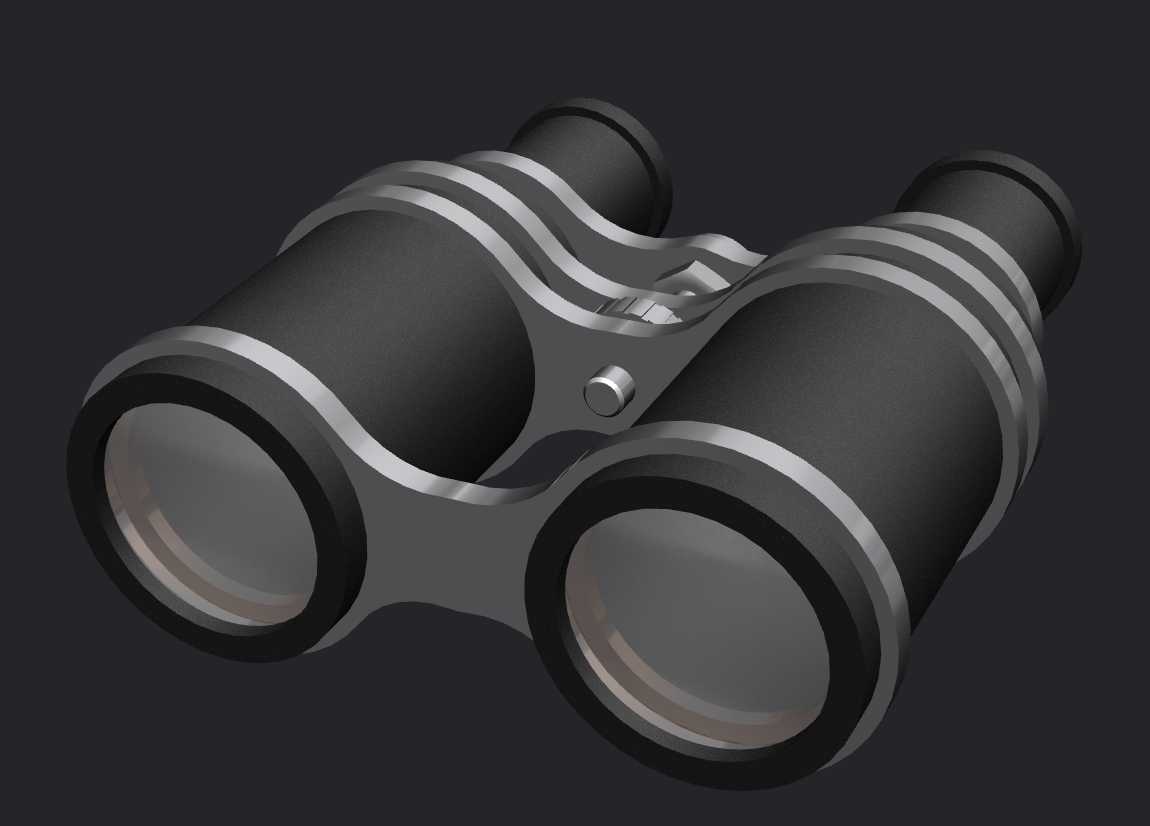The prototype of today's binoculars was an astronomical telescope, the invention of which is attributed to Galileo Galilei. The binoculars that we will build will be based on the optical scheme of this scientist. 
[001]
A binocular consists of two identical sets of lenses, each of which has two lenses: a magnifying lens, called the objective (+), and a diminishing lens, called the ocular (-). If the focal length of the objective lens is given as f1 and that of the ocular lens as f2, then the distance between these two lenses in binoculars is given by the formula L=f1+f2. In practice, this is important because the length of binoculars depends on the length of both focal lengths of the lenses used in a single set. In our example, the focal length of the F1 objective lens is 94mm, while the focal length of the F2 ocular lens is -18mm, hence the distance between the lenses: L= 94-18=76mm. With the help of such a set we will obtain a 5-fold magnification V=94/18=5. In practice we will be able to construct binoculars with the lenses used in the eyepieces. We will therefore need two identical magnifying lenses (+) with a focal length of 94 mm or similar. The diameter of these lenses may be 34-40 mm. We will also need identical magnifying lenses with a focal length of 18 mm or close to it, with a diameter of 17-30 mm. Lenses of a smaller diameter will be more difficult to acquire, so we will be content with lenses of the size used in oculars, binding them in the eyepiece as presented in [002]. The ocular holders can be moved in the objective lens holder by means of a nut in the shape of a disc grooved on the circumference and a screw. With other lenses, these dimensions will change depending on the diameter of the lenses used in the construction and their focal lengths. The distance L will then change, which in our case is 76 mm and possibly the diameter of the ocular frame and the lens. 
[002] The binoculars - dimensional cross-section drawing. 1 - objective cover 2 - wooden ring 3 - objective ring 4 - ocular cover 5 - upper ring 6 - apperture 7 - minor holder 8a,8b - major holders 9 - front holder 10 - bolt 11 - knob 12 - screw We will begin by creating a cover for the objective 1. We will make it from thin cardboard glued together in the shape of a cylinder, or from paper glued in several layers on a round wooden shaft. At the top we will glue two wooden rings 2, which we will cut out of the plywood with a small saw. The lens will be glued in at the bottom using two rings 3, cut from 3-4 mm thick plywood. Paint the inside of the frame with black ink. The frame of the ocular 4 should be glued in a similar way. The ocular lens can be glued in for this purpose without using the lower rings. You only need the upper ring 5, which you make from wood. Larger spools of thread can be used successfully here. An important part of the ocular frame is the aperture 6 in the shape of a ring cut from black paper or thin sheet metal. The size of the central opening of the aperture must be determined experimentally. To do this, we will cut out a number of apertures with different openings and simply try them out, leaving the one with which we obtain the sharpest and brightest image in the binoculars. 
[003] 8a, 8b - The dimensions of minor and major holders
Strengthening the whole structure are the frames 7, 8a and 8b and 9, which we will cut from plywood or plastic. Holder 7 will be glued with good glue to the eyeglass frames. With holders 8 and 9 we will join the two lens frames together. The movement of the eyepiece frames upwards and downwards will be achieved by means of a screw 10 with a diameter of 6 mm and a knob 11. The screw will be screwed firmly to the holder 7 by means of a nut 12. With this device we will be able to adjust the sharpness of the viewed image, however it should be noted that it will rarely happen that our lenses have the same focal length. Therefore, the distances between them will differ slightly. Before inserting a single eyepiece lens, we first test whether the image viewed through the set is clear. We will sometimes have to place one ocular lens slightly lower than the position of the other lens. It goes without saying that the magnified image can also be viewed with a single set of lens. Those who manage to get only two lenses for this purpose will be content with such an instrument. As mentioned in the introduction, it is possible to use lenses with other focal lengths, but the dimensions of the lens holders, and particularly the distance L, need to be changed. For an example, I have taken another set of lenses. The focal length of the objective lens is 400 mm (with a diameter of d-40 mm), the focal length of the ocular (-) is -70 mm with a diameter of 26 mm, then both lenses must be placed at a distance from each other of 400-70=330 mm. The dimensions of such binoculars will therefore already be, as we can see, quite considerable. However, in the field it can provide us with good service. 
[004]
• • •
|

